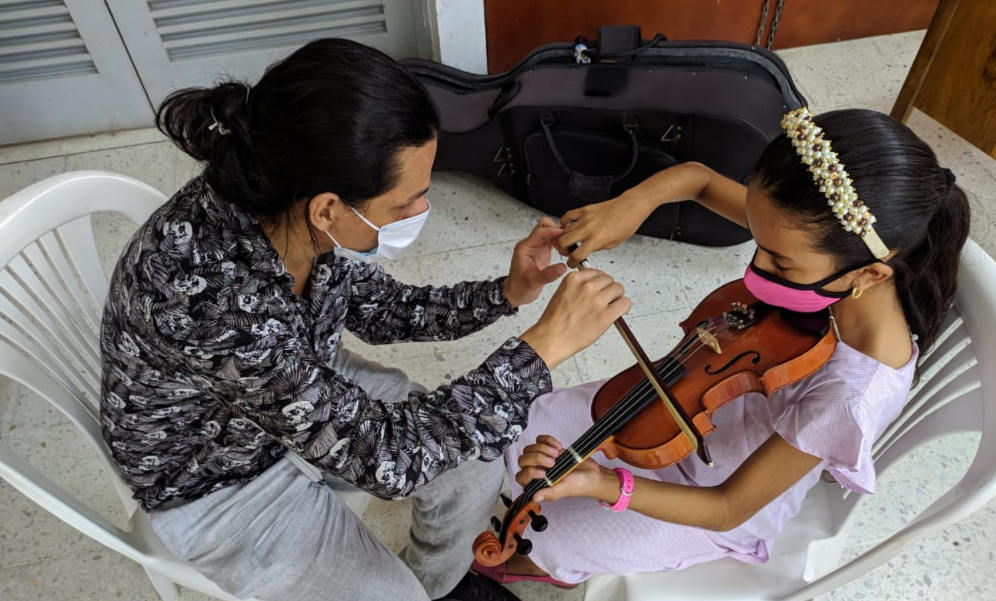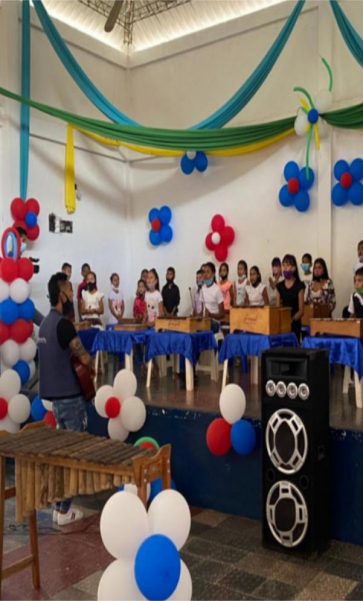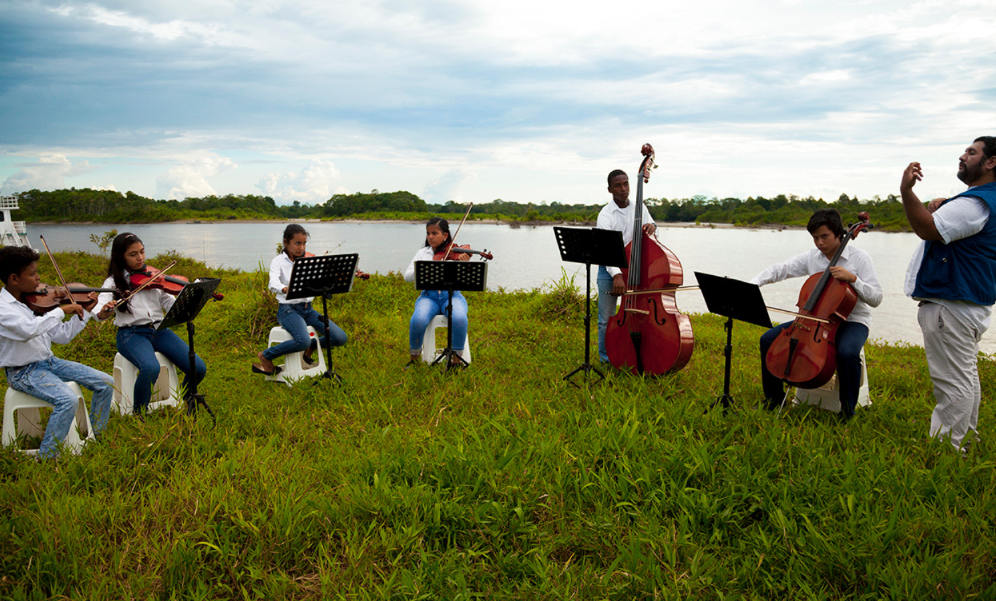After a forty-minute hike over intricate trails, slippery rocks, and crossing the Orinoco River in a bongo (a small wooden boat), music teacher José Guillermo Morales arrives at an indigenous Venezuelan village of the Curripaco ethnic group. It is the most awaited moment for the children of this community, located on the border of Vichada with Venezuela.
There, a group of children no older than 12 years sits smiling under a leafy tree. They all pick up their flutes to begin music lessons, as they have been doing for nine months, once a week. They also tune their voices and practice the songs.

The maestro’s acoustic guitar plays and everyone sings in unison: “We went out to see the wind, but the wind is not seen. We put our arms around it but the wind went away from us… Gold cob, coffee beans, wings on our shoulders, wings on our feet….”
They are part of the group of 910 students who have just graduated in different areas of the country with the Music at the Borders program, a bet for the cultural integration of Venezuelan and Colombian children, adolescents and youth, led by the National Batuta Foundation, with support from USAID and the International Organization for Migration (IOM).
How the initiative came about
This initiative arose in response to the imminent need to provide scenarios of peaceful coexistence and cultural integration for this Venezuelan population, which is exposed to factors of labor exploitation, lack of schooling, and violence in the most vulnerable host communities, explains María Claudia Parias, president of Fundación Batuta.
“Music allows children to meet each other and creates strong social bonds. It allows them to understand that we can be friends and brothers and sisters, both Colombians and Venezuelans,” says the president of Fundación Batuta.-
The project was implemented in 12 Colombian cities with the largest number of migrants and refugees who wish to stay: Medellín, Arauca, Barranquilla, Cartagena, Valledupar, Maicao, Bucaramanga, Cúcuta, Villa del Rosario, Cali, Puerto Carreño and Ipiales.
The musical education process was implemented through programs of musical initiation, choir, and orchestral training, which favor the motor, auditory, vocal and rhythmic development, as well as the creative capacity of children, teens, and young people.
This bet is inspired by the methodology created by Venezuelan maestro José Antonio Abreu, which is known worldwide as ‘El Sistema‘, a teaching model that systematized the instruction and practice of music to make it an instrument of social organization and humanistic development available to all and not only for the elites.
“Through musical practice, we can generate harmonious relations with the Venezuelan migrant and refugee population. Music is a super important mechanism to create these bonds of communication between children and adolescents of both nationalities,” adds Parias, who hopes that once the covid-19 health emergency has passed, the face-to-face concerts, which create a special connection between parents and children, will soon resume.

Strengthening integration
The Puerto Asís String Orchestra in Putumayo and the Villa del Rosario Symphony Orchestra in Norte de Santander are two examples of how the Batuta Foundation has managed to strengthen integration with children and adolescents in border areas.
“We had to make the decision, as a special mission, to go to where the children were, instead of them coming,” – Morales.-
In Vichada they are not far behind. Despite rugged geographical conditions, floods, and the absence of internet or even telephone signals, 75 children, 50 of them Venezuelan, were musically prepared, according to Jenny Castiblanco, coordinator of Social Management of the Batuta Foundation in Puerto Carreño.
To do so, in addition to discipline and love for music, the children had to arm themselves with courage and dexterity to overcome, time and again, some gigantic rocks on the banks of the Orinoco River that prevent them from reaching the capital of Vichada says teacher José Guillermo Morales.
A team of facilitators traveled once a week to the indigenous community carrying instruments such as flutes, drums, and guitars.
The musical education process was implemented through programs of musical initiation, choir, and orchestral training, which favor the motor, auditory, vocal and rhythmic development, as well as the creative capacity of children, adolescents, and young people.
This bet is inspired by the methodology created by Venezuelan maestro José Antonio Abreu, which is known worldwide as ‘El Sistema’, a teaching model that systematised the instruction and practice of music to make it an instrument of social organization and humanistic development available to all and not only for the elites.
Music that changes mindsets
In the Punta de Laja sector, near the river, an area where smuggling of goods and human trafficking networks converge, another 25 Colombian children benefited from the program.

This project generates opportunities for social inclusion.
It strengthens integration with neighbouring countries and contributes to reducing the cultural access gap between border areas and the rest of the country.
For the Venezuelan children, it was a wonderful experience.
Little Renier Unel Cayupara, 10 years old, his eyes light up when he talks about music and he never misses an opportunity to demonstrate his new skills with the drum, xylophone, or flute.
Something similar happens to Ana María Quiñónez, another little Colombian girl, also 10 years old, who does not understand nationalities and, instead, only asks to continue playing next to, she says, her new brother.
About the program
Since 2013, Música en las Fronteras has enabled the comprehensive care of more than 11,400 children in 14 municipalities in nine departments, who, particularly, are in vulnerable conditions and belong to socioeconomic strata 1 and 2, which represents 94 % of the beneficiary population.
This project generates opportunities for social inclusion, strengthens integration with neighboring countries, and contributes to reducing the cultural access gap between border areas and the rest of the country.

The closing of the program in Vichada first took place with the children of the Curripaco indigenous community at the end of July. The teachers again went to the area and presented the children with a flute. In Puerto Carreño, the graduation took place in the house of culture in mid-August. The walls of this center were filled with balloons and drawings of the Colombian and Venezuelan children. The closing song was “Tierra de Todos”, an invitation to live in harmony with refugees and migrants.


